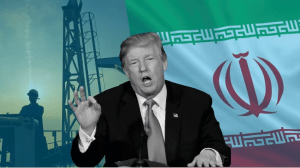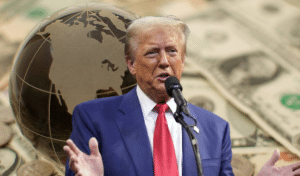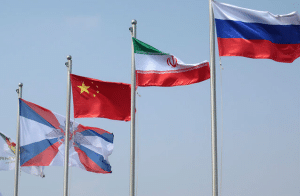PNN – The US sanctions policy against countries around the world, from Iran and Venezuela to Russia, has become a boomerang that has returned to Washington itself, challenging the economy, global credibility, and the hegemony of the dollar.
On the first day of this month, the Trump administration imposed sanctions on two giant Russian oil companies, Rosneft and Lukoil, once again demonstrating that Washington has not abandoned its sanctions-based policy. This action, which US Treasury Secretary Scott Besant claimed was taken due to Moscow’s lack of serious commitment to the peace process in Ukraine, is just the latest chapter in a long story in which the United States has become heavily dependent on sanctions.

Official statistics show that active US sanctions have increased from 912 in 2000 to 9,421 in 2021, and this trend continues. But what Washington initially promoted as an alternative to military intervention and a tool to change the behavior of target states has now become a double-edged sword that imposes heavy costs on America itself. From rising domestic inflation and lost trade opportunities to weakening diplomatic credibility and the gradual erosion of dollar hegemony, the negative consequences of this addictive policy are returning to America itself.
Sanctions madness: a lose-lose game in recent decades
Iran became the first target of Washington’s economic sanctions in 1979, when it seized a US spy den in Tehran. At that time, the Carter administration froze about $8.1 billion in Iranian assets and imposed broad trade sanctions. This was just the beginning of what would become a four-decade-long, worn-out policy. The Trump administration, in its first term, raised sanctions on Iran to the highest level by withdrawing from the JCPOA in 2018 and applying “maximum pressure,” and in its second term, ordered the same policy reinstated.

US Congressional reports show that Iran is just one of more than 30 countries targeted by new US sanctions between 2018 and 2025. Along with Iran, Venezuela has been under extensive “maximum pressure” sanctions since 2019. Cuba has also been under Washington’s economic blockade for more than six decades. North Korea, Syria, Myanmar, Zimbabwe, Sudan, Yemen, and Belarus are among other countries that have been under the pressure of US sanctions for years.
But Washington’s latest move on October 22, 2025, targeting Rosneft and Lukoil, two Russian oil giants responsible for producing about half of the country’s oil and 2% of global oil production, shows that the Trump administration has returned to a sanctions-based policy, despite previous hesitations. These companies, each valued at more than $50 billion, are now on the Specially Designated Nationals (SDN) list, and foreigners will face the risk of secondary sanctions if they do business with them.
Researchers at the Peterson Institute for International Economics have shown in a comprehensive study that US sanctions cost the country’s economy about $15 billion annually. American companies are deprived of export opportunities, and sanctions increase inflation and the cost of living within the United States. After the announcement of sanctions on Rosneft and Lukoil, global oil prices quickly rose by about 5%, and experts warned that this increase could be passed on to gasoline prices in the United States and reduce the popularity of the Trump administration.

Energy sanctions against Russia, imposed after the 2022 invasion of Ukraine, had a severe negative impact on the European economy. Germany, Europe’s largest economy, recorded a historic low in March 2022, with its investor confidence index falling to -39.3 (compared to 54.3 in February). The Organization for Economic Co-operation and Development (OECD) predicted that sanctions on Russia could shave 1 percentage point off global economic growth and add at least 2 percentage points to global inflation. These losses would not only affect the sanctioned countries, but also US allies and Washington itself.
The erosion of the dollar’s credibility; the response of emerging powers and alternative markets
One of the most important consequences of America’s sanctions-based policy is the gradual weakening of the dollar’s hegemony in the global financial system. According to the International Monetary Fund, the dollar’s share of global foreign exchange reserves has declined from 72% two decades ago to about 59% in 2024 and 57.8% at the end of 2024. This downward trend continues to accelerate, and central banks around the world are looking for alternatives to the dollar.

The BRICS group, now 10 members with the addition of Egypt, Ethiopia, the United Arab Emirates, Iran and Indonesia, is pushing ahead with serious plans to reduce its dependence on the dollar. China and Russia now conduct more than 50 percent of their bilateral trade in yuan and rubles, bypassing the dollar entirely. Iran and India also conduct more than 95 percent of their trade in rials and rupees. This trend is expanding; India has signed similar agreements with the UAE, Indonesia, and other countries to use national currencies.
The China Interbank Payment System (CIPS), an alternative to SWIFT, has reached 1,467 indirect participants in 119 countries by January 2025, connecting 4,800 banks in 185 countries. Although China’s interbank payment system is still smaller than SWIFT, its rapid growth reflects growing confidence in yuan-based financial networks. Russia has also developed its own Financial Messaging System (SPFS), which now connects banks in several countries.
The New Development Bank (NDB), established by the BRICS countries in 2014, increasingly disburses its loans in local currencies and, unlike the IMF, does not impose strict political conditions on its loans. This allows member countries to avoid the risks associated with dollar-denominated debt.

Significant developments are also taking place in the oil market. In 2018, China launched yuan-denominated oil futures contracts on the Shanghai Energy Exchange, which are convertible into gold on the Shanghai and Hong Kong gold exchanges. This allowed China to purchase oil without the need for dollars and create a non-dollar pricing mechanism for the strategic commodity. Given that China is the world’s largest oil importer, this financial instrument could pose a serious challenge to the petrodollar system.
The World Gold Council reported that central banks purchased more than 244 tons of gold in the first quarter of 2025, and that almost 20% of the world’s central bank assets are now in gold. This is the highest level in decades, with 95% of central bankers planning to increase their gold holdings next year, reflecting a widespread flight away from the dollar and a return to safer assets.
From diplomatic isolation to a rift in the Western alliance
Another heavy cost of America’s sanctions-based policy is the weakening of diplomatic credibility and the creation of a rift in relations with traditional allies. The European Union, which initially joined the US in imposing sanctions on Russia, has gradually complained about the heavy costs of these sanctions. German, French, and Italian industries that had invested in the Russian market for years were forced to close or scale down their operations.
The Holmes-Burton Act and the Iran-Libya Sanctions Act (ILSA), which impose secondary sanctions on foreign companies operating in Cuba, Iran, and Libya, have drawn strong ire from the European Union and Canada. Europeans see these actions as US interference in EU interests and affairs and as a tool of US economic warfare. Indeed, the European Commission announced in 2018 that it would invoke the 1996 Blocking Regulation to declare US sanctions against Iran illegal.
Domestically, public distrust of foreign policy is also growing. Polls show that American citizens are increasingly critical of the costs of foreign interventions, including sanctions. Trump himself admitted in June 2025: “When I sanction a country, it costs the United States a lot.” These statements indicate that there is a growing understanding of the costs of sanctions even among American politicians.

Internationally, US sanctions have brought sanctioned countries closer together. Iran, Russia, China, North Korea, and Venezuela have strengthened their economic, diplomatic, and in some cases military cooperation. These countries are developing their own financial and trade channels to bypass the oppressive sanctions and keep their economies stable. In fact, rather than dividing these countries, the sanctions have united them in an anti-Western axis.

